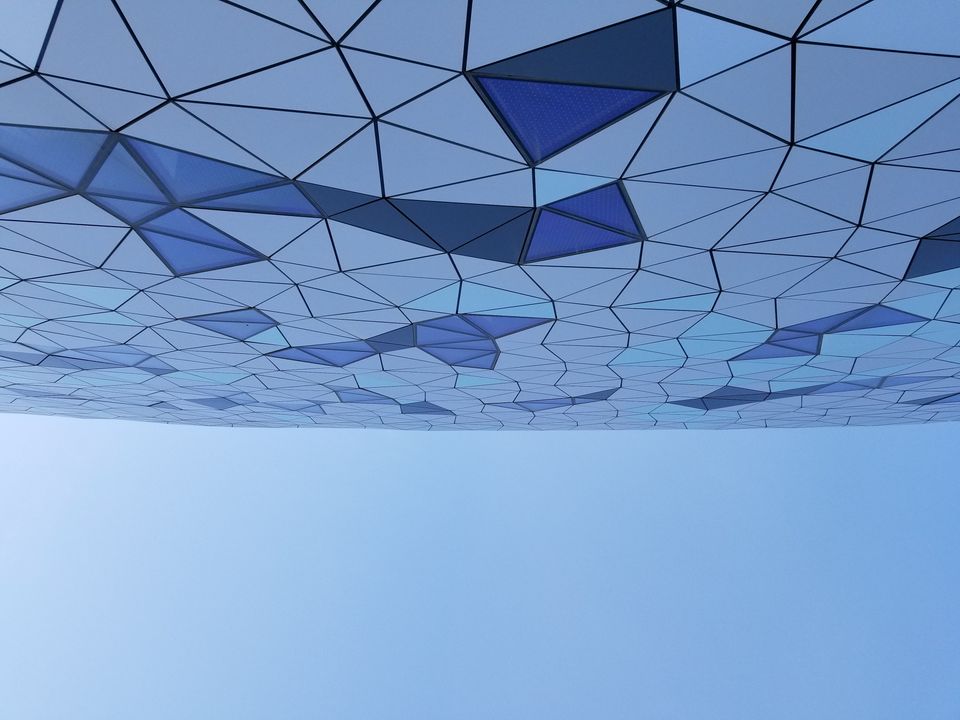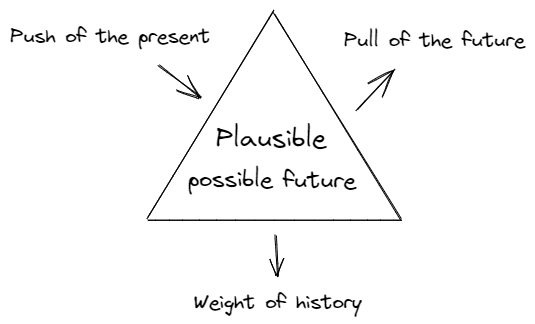The Futures Triangle

The Futures Triangle method was invented by Sohail Inayatullah [1] [2], known for his work on the future technique of causal layered analysis. The method helps in figuring out plausible possible futures based on observations mapped in trends (Push of the present), existing surrounding environment (weight of history), and aspirations for the future (pull of the future).
There is an easy-to-read article describing the Futures Triangle in simple terms by Chris Riedy at Medium service (behind a paywall)[3]. The original paper where the method was published was Six pillars: Futures thinking for transforming by Sohail Inayatullah[4].
This article describes the slightly adapted version of the Future Triangles, as seen in Sitra's Megatrends report 2023[5], wherein the placement of the descriptive text on the sides and not the points of the triangle feels more intuitive to yours truly.
The adapted Futures Triangle, for mapping plausible possible futures
The visualization is derived from the design, which is assumed to be by Topias Dean.

As depicted by the arrows, the forces in the drawing are used to describe the forces and trends at play in shaping and influencing plausible possible futures.
The plausible futures refers to likely or possible futures, of which there is expected to be more than one, with varying probability. The interaction, and tension between the given forces, with different strengths, leads to a likely plausible outcome. The outcome's plausibility depends on the quality of observations and predictions on the forces. Predicting the future is not possible with the means available to me, but the tool can be useful in scenario planning.
Push of the present
The forces and transformational movements that are already in motion.
You can map the forces and influences by observing our current environment, surroundings, and trends. The Push of the present draws attention to what is changing right now[5].
When creating the mapping, the observations describe what trends are pushing us towards particular futures?[3] In collecting notes on the current environment, the observations can also describe the Push of the present, without a destination, the plausible possible future, in mind.
The Push of the present could, for example, contain movements like current transformational processes, such as economy, technology, culture, etc.[5]
It may be helpful to think of these forces as with strength, quantification, speed, and direction of the movement rather than just strength.
Weight of the history, past
These are the already existing influential structures such as practices, culture, habits, and beliefs that inhibit or oppose transformation. These forces root us in the present and may cause an ongoing shift to appear weaker or harder to identify. The weight of the past guides us to observe how we arrived at this moment.[5]
When drawing the mapping, these observations list related existing and relatively static forces and factors. Examples of such forces are continuities, belief systems, worldviews, barriers to change, etc. [5]. It is necessary to identify the things that lead us to believe that the change is unlikely or even impossible, the norms and structures that resist and oppose change on the topic.
It is helpful to list these influences with a neutral or external perspective through pre-determined topics, such as laws and regulations, beliefs and cultural practices, and challenge if the answer is the same in a different context.
Pull of the future
These are the forces that pull toward a future state of things. Where the Push of the present includes trends with strength and velocity toward a given future, the pull of the future describes forces that make it aspirational, attractive, and tempting to move toward a defined future. The pull of the future covers visions of the future, whether they are utopian, dystopian, or something in between.[5]
When mapping the topics in the pull of the future, we can list topics like (mental) images of the future, dreams, wishes and hopes, plans, etc.[5] The influencers here should include motivations to take some particular path, but also compelling images of the future….you "can't not go there".[3]
Template for listing the observations
Plausible possible future:
| Push of the present | Weight of the history | Pull of the future |
|---|---|---|
| (list evidence) | (list evidence) | (list evidence) |
| - | - | - |
For each of the categories above, it can be useful to include the strength, quantity, direction, speed and direction in the evidence or symptoms of change.
References
[1] “Sohail Inayatullah.” Wikipedia, Wikimedia Foundation, 7 Jan. 2023, https://en.wikipedia.org/wiki/Sohail_Inayatullah.
[2] “Articles by Sohail Inayatullah.” Metafuture, Metafuture.org, 2 Jan. 2023, https://www.metafuture.org/library-page/articles-by-sohail-inayatullah-1/.
[3] Riedy, Riedy, Chris. “The Futures Triangle.” Medium, Medium, 15 June 2017, https://medium.com/@chrisjriedy/the-futures-triangle-7ef2ed728a02.>
A derivative work based on Six pillars: Futures thinking for transforming, by Sohail Inayatullah 2008.
[4] Inayatullah, Sohail. “Six Pillars: Futures Thinking for Transforming.” Six Pillars - Futures Thinking for Transforming Foresight Vol 10 Issue 1 2008, vol. 10, no. 1, ser. 2008, 30 July 2007, pp. 4–21. 2008, https://doi.org/10.1108/14636680810855991.
[5] Dufva, Mikko, et al. “Megatrendit 2023.” Edited by Mikko Dufva et al., Sitra, The Finnish Innovation Fund Sitra, 10 Jan. 2023, https://www.sitra.fi/julkaisut/megatrendit-2023/#tulevaisuuskolmio-ohjaa-ajattelemaan-muutosta-syvallisemmin.
Picture, diagram 2: Futures triangle helps determine plausible possible futures—an adaptation of the work by Inayatullah 2008. The visual adaptation is assumed to be done by Topias Dean, who is credited with the visual design of the publication.
[6] Photo by Don Daskalo on Unsplash